It's been 10 years since the Big Flood. How the changing climate is shaping life in Calgary
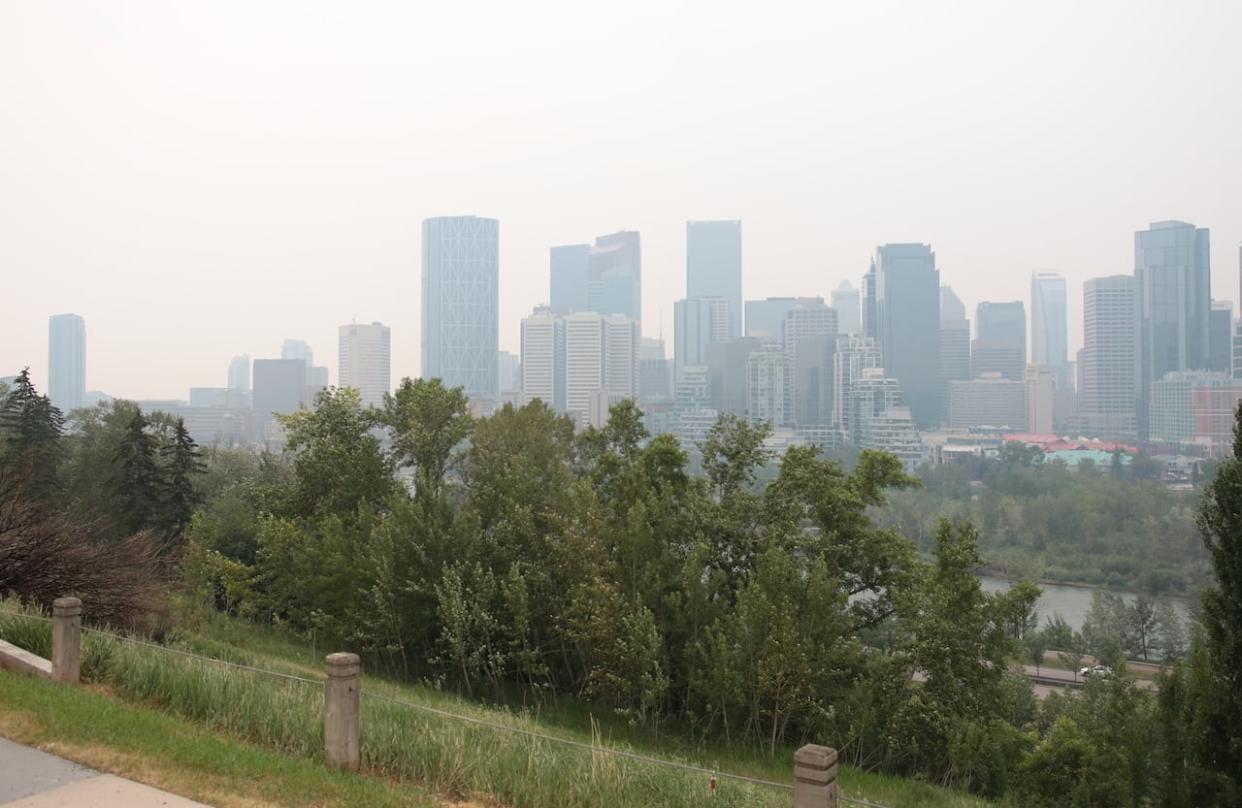
In the decade since the Big Flood of 2013, Calgary has seen a number of extreme weather events and scorching, smoky summer days.
Four Calgary disasters are included in the Insurance Bureau of Canada's Top 10 list of costliest years for insured losses in Canada — three since the flood, the fourth occurring the year before.
The past decade has seen a surprise September snowfall in 2014, a devastating hailstorm in 2020 that resulted in $1.2 billion in damages, and a sweltering and deadly heat dome in the summer of 2021.
A number of "catastrophic" weather events have been recorded in almost every year since June 2013, resulting in billions of dollars in damages.
It was the $5-billion flood in 2013 that jolted many Calgarians into a serious conversation about the impact the changing climate is having on the city and southern Alberta.
There have been dozens of extreme heat warnings and air quality advisories because of smoke from wildfires.
The number of smoke hours has increased along with the average summer temperature.
Since the flood, Calgary has recorded 32 new record high temperatures.
The average number of warm nights has increased, something that is linked to an increase in hospital visits.
Environment and Climate Change Canada issued 20 heat warnings in Calgary covering 113 days between 2017 and 2022. The warnings are issued when the daytime temperature reaches at least 29 C or the nighttime temperature stays at 14 C or higher for two consecutive days.
Over that same period, there were 28 special air quality statements covering more than 70 days due wildfire smoke. The number of thunderstorm hours observed at the airport has also increased.
"We've had incredible hailstorms. We've had 'Snowtember' events, more of these damaging storms. We are seeing heavier snow storms through the winter and we're seeing more rain at more times of the year than what we would have traditionally seen going back in the climate record," said Jillian Curley, acting leader with the city's climate adaptation team.
The city also says there has been an increase in intense rainfalls and bigger snowfalls during individual snow events.
The seasons are shifting, with a later fall frost and an earlier start to spring (this May was the second hottest on record for Calgary.)
'It's like living on Mars'
A year ago, the city asked people how severe weather has impacted their lives. The responses ranged from fear and anxiety to skepticism about climate change.
"I've not seen a big difference in the 40-plus years of being an adult in this city," read one of the anonymous replies.
"It got hot, it got cold, the Earth kept spinning," read another.
"Calling a couple weeks of hot weather 'extreme' is complete nonsense."
But there was also concern and anguish.
"Anxiety inducing — especially knowing this will become something more frequent."
"The wildfire smoke and heat impacts all of us, especially my son, who doesn't get to enjoy outdoor activities in a real summer. It's like living on Mars."
"The excessive heat and wildfire smoke impacts my physical and mental health."
Others recalled their experience during the June 2013 flood: being forced from their homes, losing income, paying for costly repairs and higher insurance premiums.
Climate change and the Bow River
While the Bow River hasn't reached the same destructive flows seen in 2013, the city's biggest source of drinking water has been impacted by climate change, according to the Canada Research Chair in Water Resources and Climate Change at the University of Saskatchewan.
John Pomeroy says extreme low river flows have been recorded in late summer and early fall, but also some very large snowpacks have led to high river flows. He says glaciers are continuing to recede, and water management on the river has changed. He says TransAlta's reservoir at Ghost Lake no longer operates solely as a hydroelectric facility but also as a flood mitigation tool. Water is drawn down in the spring to make room to hold back potential flood waters.
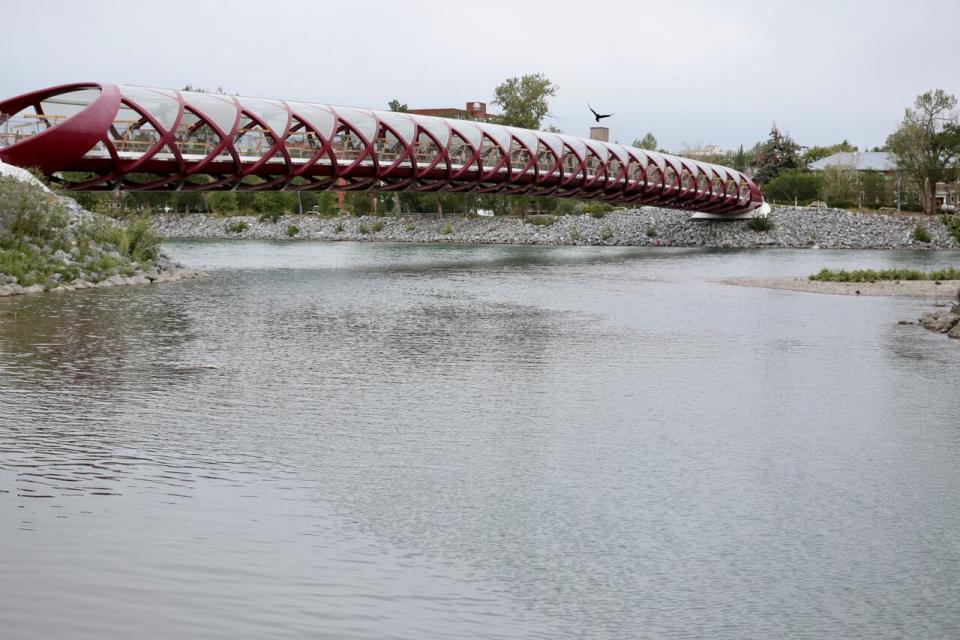
A below normal snowpack, early spring melt and warm temperatures in May and June have led to below normal flow rates in the Bow River this spring. (Bryan Labby/CBC)
Pomeroy says snowpacks at lower elevations continue to decline, which affects the amount of water flowing into the river. He says this spring is a possible prelude of what's to come: below normal snowpack along with very warm temperatures in May and June, which have led to low river flows for this time of year.
"That means a greater reliance upon rainfall, and rainfall is less reliable than snowmelt," he said.
He says we could see very long dry spells, which could exacerbate drought conditions.
The big climate plan
It's been 581 days since the city declared a climate emergency in November 2021. It has since updated its $256-million climate change plan. The short-term goal is to reduce greenhouse gas emissions by 60 per cent of 2005 levels by 2030, and to be net-zero by 2050.
The city has said it is "not yet on track" to meet either target.
The main contributors to greenhouse gas emissions are carbon dioxide from fossil fuels used to heat homes and buildings and fuel transportation needs.
Every year of inaction means the pace and scale of action must intensify. - City of Calgary's GHG modelling report
One of the key strategies to reduce emissions includes retrofitting existing homes and encouraging new homes to be built to net-zero standards. It's a monumental task. The city says 52 retrofits would have to be done every day, or 19,000 a year, to reach the 2050 goal.
On the transportation side, an electric vehicle adoption rate of 82,000 per year would have to be met.
"Developing the capacity to meet these targets is key and is undoubtedly one of the greatest challenges that Calgary faces to achieve a net-zero future," says the city's GHG modelling report.
The report issues another warning: "Every year of inaction means the pace and scale of action must intensify."

The city says an electric vehicle adoption rate of 82,000 per year would have to be met to accomplish net-zero by the 2050 target. (Bryan Labby/CBC)
The report acknowledges the city can't do it alone. It will need help from the provincial and federal governments.
"For example, how quickly and to what extent the Alberta electricity grid decarbonizes, the pace and scale of federal carbon price increases and the implementation of other provincial and federal net-zero policies, regulations, programs and funding."
More money for bike lanes, less for roads
The Calgary Climate Hub, which encourages action on climate change, empathizes with the city to some extent because many of the required changes fall to other levels of government.
But Robert Tremblay says the city should do more to decarbonize Enmax, its wholly owned electricity utility. He says the city can also improve the transit, bikeway and pathway networks, provide more vehicle charging stations and electrify home heating and cooling systems. The group is also calling for the electrification of the city's bus fleet, the build out of the Green Line LRT and an LRT connection to the airport.
Tremblay, who is also a member of the city's climate advisory panel, was asked if he thinks the city's actions have matched its climate goals.
"We're continuously improving on this, so I think it's not about whether it's been met yet or not, the nature of climate action is that it's never going to be enough until eventually we get there. So it's up to us and the climate team and council to keep pushing," said Tremblay.
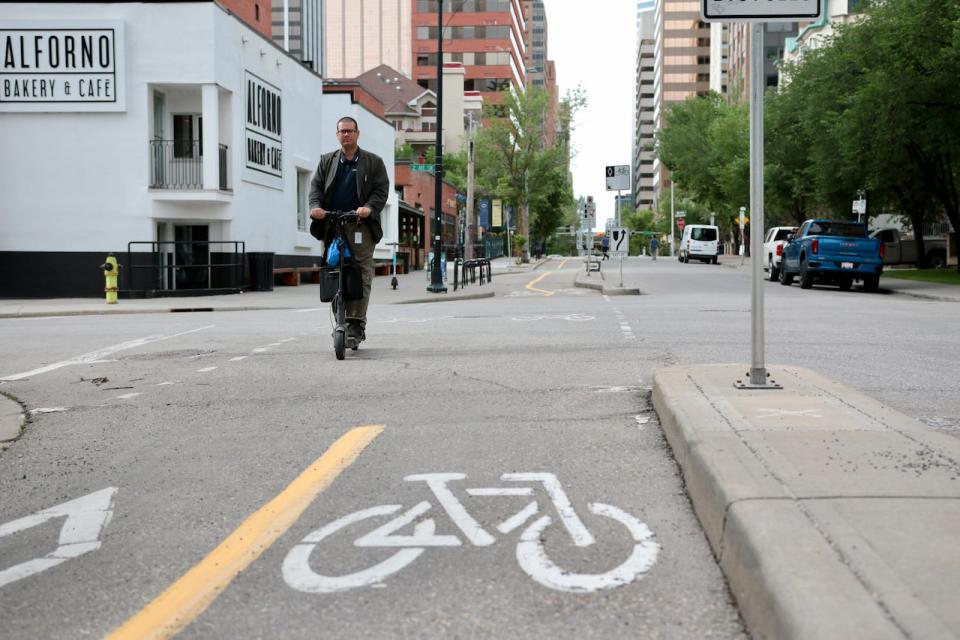
Sustainable Calgary would like to see more money spent on active transportation networks such as separated bike lanes. (Bryan Labby/CBC)
Sustainable Calgary, another advocacy group, applauds the city for adding resources to its climate team and updating local policies around municipal planning and cycling and walking networks. But it wants more action to reduce CO2 emissions.
Noel Keough, one of the group's co-founders, says more priority needs to be given to building cycling lanes rather than roads, making transit a more reliable and viable option and to reign in urban sprawl. He agrees with others who have called for a moratorium on suburban growth and focus more on developing in established areas, including light industrial zones, surface parking lots and land near LRT stations.
"We have one of the most sprawling cities in North America. We continue to — against the policy of the municipal development plan — approve predominantly suburban units for development," said Keough.
Building greener, cleaner
Since our homes contribute about a third of the city's greenhouse gas emissions, retrofitting older homes to a net-zero standard and building new net-zero homes is a main target.
A Calgary homebuilder who specializes in net-zero home construction says the double-wall insulation, heat pump and solar panels add about 10 per cent to the cost of a net-zero home compared with a regular build. He has lived in a net-zero home for five years, and last year received a $1,000 credit on his utility bill as his home produced more energy than it consumed.
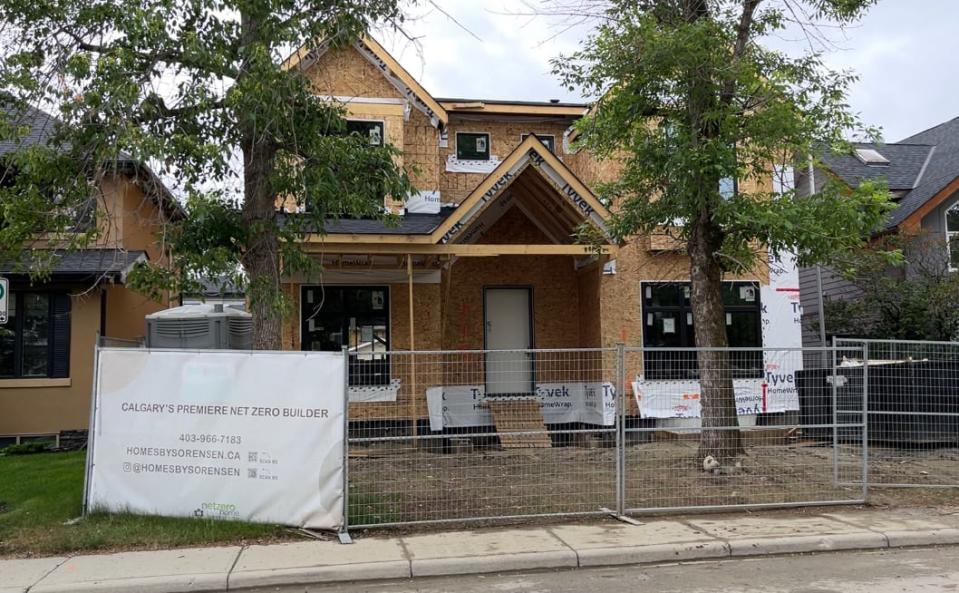
A net-zero home under construction in the northwest Calgary neighbourhood of Parkdale. The home will produce as much energy as it consumes. (Bryan Labby/CBC)
Axel Sorensen, owner of Homes by Sorensen, says his company builds approximately 10 new homes a year, eight of them are net-zero. He says the biggest challenge for the city to reach net-zero status will be retrofitting existing homes — and it's not cheap. The Pembina Institute estimates the cost is between $60,000 and 100,000 per home.
He says people want to reduce their carbon footprint and are also enticed by much lower or non-existent natural gas and electricity bills.
"They realize that added mortgage cost is completely offset, if not a bit more, from the decreased utility cost," he said.
Cooler summers for some
If you live in Calgary, you may have heard a few more air conditioners humming in your neighbourhood or you may purchased one yourself.
Statistics Canada says that in the past 10 years, the number of homes with either central air conditioning or some other type of air conditioning increased from 26 per cent to 37.
Danny North says he is installing one to two units a day in Calgary and is looking to hire more people to help meet the demand.
"Over the last three to five years, it's probably doubled in how much we usually do," said North, owner of Northstar Heating & Cooling.
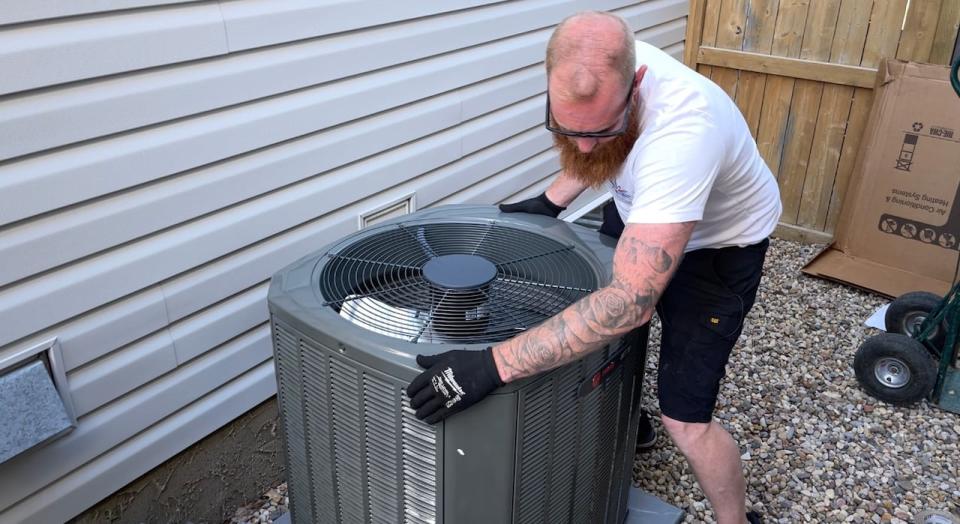
Danny North, owner of Northstar Heating & Cooling, installs a new air conditioning unit in northwest Calgary. (Bryan Labby/CBC)
One of his customers says he's been thinking about it for a decade but finally pulled the trigger this year. He works from home and found heat in his second-floor office unbearable at times.
"It's a comfort measure. We've been thinking about installing A/C for the last 10 years as temperatures have risen. It's been more incentive for us to bite into it," said Ivan Sierralta.
One of the factors Sierralta considered was the increase in energy consumption required to keep the house cool. In the end, he chose personal comfort.
It's a decision more people are making in the face of warmer summer days and nights.
Bryan Labby is an enterprise reporter with CBC Calgary. If you have a good story idea or tip, you can reach him at bryan.labby@cbc.ca or on Twitter at @CBCBryan.


